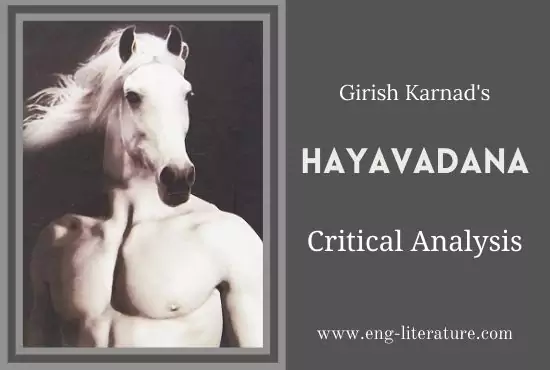Hayavadana Critical Analysis
Girish Karnad is a gifted writer, actor and director of films. He is the well-known author of the Kannada plays entitled Tughlaq and Yayati. Now he has translated into English his own work Hayavadana. It is mainly based on the famous Katha Sarit Sagara tale that Thomas Mann made use of, for his short but great novel The Transposed Heads. In all his three plays-whether the theme is historical or mythical or legendary- Karnad’s approach is modern. He wonderfully brings into play the conventions and motifs of folk-art like masks and curtains in order to project a world of intensities, uncertainties and unpredictable denouements.
Devadatta and Kapila are close friends. The former is an intellectual companion, while the latter is of a sensual type. Devedatta is already married to a lady named Padmini. But later Kapila falls in love with her. The two friends, so as to get over the situation, decide to kill themselves. They perform the act. Padmini transposes the heads, while rejoining the severed limbs. It naturally results in confusion of identities and several complications arise from it. It drives them to fight a duel and they kill themselves again. Then Padmini ascends their funeral pyre and performs Sati (Dying along with the husband). It is a highly tantalizing story, even without the psychological dimension and Karnad very ably makes the most of it.
Hayavadana is one of Karnad’s most remarkable works. The plot of Hayavadana comes from ‘Kantha Sarit Sagara‘ an ancient compilation of stories in Sanskrit. The central event in the play- the story of Devadatta and Kapila is based on the tale from the “Betal Panchabinsati.” But he has borrowed it through Thomas Mann’s retelling of the story in ‘The Transposed Heads.’
The Sanskrit tale told by a ghost to an adventurous king gains a further mock-heroic dimension in Mann’s version. The original story poses a moral problem, whereas Mann uses it to ridicule the mechanical notion of life which differentiates between body and soul. He ridicules the philosophy which holds the head superior to the body.
The human body, Mann argues is a device for the completion of human destiny. Even the transposition of heads did not literate the protagonists from the physiological limits imposed by nature. Karnad’s poses a different problem, that of human identity in world of tangled relationships. When the play opens, Devadatta and Kapila are the closer of friend’s one mind, one heart as Bhagavata describes them. Devadatta is a man of intellect, Kapila a man of the body. Their relations get complicated when Devadatta marries Padmini.
Kapila falls in love with Padmini and she too starts drifting towards him. The friends kill themselves in a scene, hilariously comic, but at the same time, full of dramatic connotations Padmini transposes their heads, giving Devadatta Kapila’s body and Kapila Devadatta’s. As a result Padmini gets the desired ‘Man.’ Kali understood each individuals moral fibre and was indifferent than the usual stereotypical portrayal of God and Goddesses.
The result is a confusion of identities which reveals the ambiguous nature of human personality. Initially Devadattaactually the head of Devadatta on kapila’s body-behaves differently from what he was before. But slowly he changes to his former self. So does Kapila, faster than Devadatta. But there is a difference. Devadatta stops reading texts, does not write poetry, while Kapila is haunted by the memories in Devadatta’s body.
Padmini, after the exchange of heads, had felt that she had the best of both the man, gets slowly disappointed of the three, only she has the capacity for complete experience. She understands, but cannot control the circumstances in which she is placed. Her situation is beautifully summed up by the image of river and the scare-crow in the choric songs.
The sword fight that leaves both the friends dead brings to baffling story to end. The death of three protagonists was not portrayed tragically… the death only to emphasise the logic behind absurdity of the situation.
The sub-plot of Hayavadana— the horse-man, deepens the significance of the main theme of incompleteness, by looking at it from different perspective. The horseman’s search for completeness ends comically with his becoming a complete horse. The animal body triumphs over what is considered the best in man, the ‘Utta Maga’, the human head’s probably to make a point, Karnad names the play ‘HAYAVADANA’ human’s search for completeness.
Also Read:
Karnad uses the conventions and motifs of folk-tales and folk-theatre-marks, curtain, dolls and the story-within-a-story to create a bizarre world. His play’s plot revolves around a world of incomplete individuals, indifferent gods, dolls that speak and children who cannot, a world unsympathetic to the desire and frustration, joys and sorrows of human beings. What is real is only the tremendous, absurd energy of the horse and its rider who move around the stage symbolizing the powerful but monotonous rhythm of life.
Karnad’s work has the tone and expression of great drama. He has outstanding ability and the power to transform any situation into an aesthetic experience.

Hello, Viewers! Besides being the Founder and Owner of this website, I am a Government Officer. As a hardcore literary lover, I am pursuing my dream by writing notes and articles related to Literature. Drop me a line anytime, whether it’s about any queries or demands or just to share your well-being. I’d love to hear from you. Thanks for stopping by!
